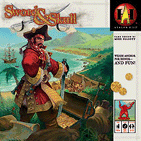
|
About OgreCave and its staff
|

|
by Merwin
I received the opportunity to review Sword & Skull after I'd read other reviews of the product. In my book, that's a big no-no. I much prefer to review a game without being tainted by other's opinions. But, since my memory stinks, I felt relatively secure in my ability to give the game a fair shake. So imagine my surprise when the first two words that came to mind when I opened the box were the same two words that many others before me had used to describe Sword & Skull. Was I channeling other reviewers viewpoints, or was this game so transparently derivative of other games? Guess what? You get to be the judge. Oh, and by the way: I'm never going to be directly using those two words/games to describe this game in this review. After all, the Ogre strives to deliver unique content.
Pieces of Crate There's also a quad-folded game board, a single pack of shrinkwrapped cards, and a bunch of cheap plastic doubloons in 1s, 5s, and 10s. The two best components happened to be the 10 plastic figures - five different colored pairs of identical officers and pirates - and the three very interesting pipped six-sided dice, which look like someone tried to carve out the pips with a rock and chisel. The gratingly text-heavy board has a rectangular outer track with eight segments (includes corners) to a side. The center square of each side is identical. Each of the four sides has 2-4 like-colored segments that fall into a single category, such as two yellow Port Rum spaces or three green Smuggler's Cove spaces. The center of the board has a trail leading from one of the outer segments to meet the Pirate King or, if your nerves fail you, branching to an outer segment on the opposite side of the board.
Git Goon, Ye Scurvey Dawgs! Each player receives a like-colored pair of officer and pirate figures. They begin "off" the board, two spaces apart, and always move a number of spaces clockwise around the board as dictated by the dice. They run around the outer track, following instructions on the spaces until they collect enough gold to pay off the Pirate King, or enough combat strength to defeat him. Apparently he's got some fancy ship you must recover. Landing on spaces results in fighting stuff, gaining/losing gold and/or gaining/losing support cards. You always fight (opposed dice rolls) when the opportunity provides itself. If you land on other players, you fight them. Fighting random enemies out of the deck provides variable rewards. Fighting a player results in an exchange of two gold or a support card. Support cards come in two flavors: cards you hold in your hand for emergencies (Fortune), and Items or Crew you have in front of you to build up your combat or crew influence. Icons on cards indicate additions to pirate combat (pistols), officer combat (swords) or influence (gold coins). Anyone recruiting Crew from a given color must pay (rent to) anyone who has influence (gold icons) in that color. So, as parallels to this review's unspeakable two words, we've got: Enemy = Adventure There's derivative, and then there's Sword & Skull.
Polly Got a Sucker? I claimed earlier that the game was "off-theme." Here's why: it doesn't seem to matter which character you use, except when you fight and have to add up swords or pistols. The pirate, who can only use guns from items and pirate crew, can wander around and collect cutlass items and officer crew, which your officer can then magically access. Yick. At least other games with multiple characters have you maintaining those characters separately. When playing the game for review purposes, we misplayed the game in a way that greatly speeded up gameplay. (For the morbidly curious, we misread the Treasure Chest spaces as "For every other treasure chest with fewer than five gold coins, place one coin on this space." No harm done, since the game would otherwise have taken twice as long. While it was immediately apparent which Crew contributed combat strength to the pirate or officer, we couldn't figure out whether all the game rules referring to Crew for other reasons were intended to be character specific (officer crew or pirate crew), or player specific (all crew held by a single player). This is where the ambiguity kicked in. We imposed a houserule to avoid insanity and rickets. On the other pegleg, it's an excellent kids' version of Talismanopoly. Run around, collect gold and strength, try to avoid getting beat up by and/or paying off other players and enemies. Ultimately head up the inner path to defeat/pay off the Pirate King. Even for kids, however, the thrill won't last. There's just not enough rules clarity, variability, physical attraction or replayability in the game. At least, not for the price.
Bottom hook, line, and stinker
|
||
 Sword & Skull
Sword & Skull